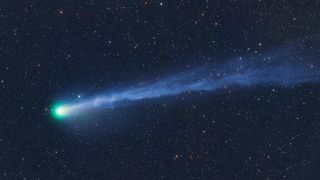
The green colored comet 12P/Pons-Brooks is currently racing toward the sun before a close encounter with Earth later this year (pictured March 4).
(Image credit: Michael Jäger)
An explosive, green comet racing toward Earth is currently zooming past the nearby Andromeda galaxy in the night sky, setting the stage for some stunning photographs. You can also watch the comet fly past our spiralling galactic neighbor in real time, thanks to a pair of upcoming livestreams.
Comet 12P/Pons Brooks (12P), also known as the devil comet, is a 10.5-mile-wide (17 kilometers) comet that circles the sun on a highly elliptical orbit every 71 years or so. 12P is a cryovolcanic, or ice volcano, comet. This means that it occasionally erupts when solar radiation cracks open its icy shell, or nucleus, allowing it to shoot out a combination of ice and gas, known as cryomagma, into space. When this happens, the cryomagma massively expands 12P’s coma — the cloud of gas and dust surrounding the nucleus — making the comet appear much brighter for the next few days.
In July 2023, astronomers watched 12P blow its top for the first time in almost 70 years, and it has erupted reasonably frequently ever since. During the comet’s early eruptions, 12P’s expanded coma grew lopsided thanks to a notch in its nucleus, making it look like it had grown a pair of demonic horns. However, following more-recent eruptions, the horns seem to have disappeared for good. Newer photos of the comet also show that it has developed a green glow, which is caused by high levels of dicarbon (two carbon atoms stuck together) in its coma and tail, which is quite rare.
12P is expected to make its closest approach to Earth on June 2 after first slingshotting around the sun in late April. After it passes us, it will then journey back into the outer reaches of our cosmic neighborhood, where it will spend a majority of the next 70 years.
As it continues to hurtle toward the inner solar system, 12P can now be spotted in the same part of the night sky as the Andromeda galaxy — a spiral galaxy located around 2.5 million light-years from the Milky Way, which is destined to collide with our own galaxy in around 4.5 billion years.
You can watch this extremely rare conjunction (an astronomical phenomenon that occurs when two objects appear close in the sky, despite being trillions of miles apart) take place in real time thanks to two livestreams from the Virtual Telescope Project, which will showcase the cosmic spectacle as seen from the project’s observatory in Manciano, Italy from 2:30 p.m. ET on Sunday (March 10) and Tuesday (March 12).
Related: Related: In a 1st, scientists predicted that volcanic comet was due to pop ‘like a Champagne bottle’ — and it did

12P (bottom right) is currently in close proximity to the Andromeda galaxy (top left) in the night sky. (Image credit: Virtual Telescope Project/Gianluca Masi)
For now, the wide conjunction is most clearly visible just above the horizon after sunset, according to Spaceweather.com. Andromeda is visible to the naked eye with clear skies but you will need a good telescope, camera or decent pair of stargazing binoculars to spot 12P, which is around 10 degrees below the galaxy. (That’s approximately the same width as your fist when held up to the sky, according to Time and Date.)
The Virtual Telescope Project has already captured a stunning long-exposure shot of 12P and Andromeda shining side-by-side (see above).
Astrophotographer Petr Horálek, has also captured a series of stunning images of the pair from Slovakia. The Triangulum galaxy (M33) and the star Mirach, often used as a “guide” to find Andromeda, are also clearly visible in these photos.
This is not the first time that 12P has photobombed a cosmic structure: In January, the comet passed in front of the Crescent Nebula — a massive cloud of ionized red gas located 5,000 light-years from Earth.
Astrophotographers are also hoping to snap the comet during the upcoming total solar eclipse on April 8, when 12P will be orientated very close to the temporarily obstructed sun. If it erupts in the days leading up to the eclipse, the comet may also be visible to the naked eye during totality.
Get the world’s most fascinating discoveries delivered straight to your inbox.
Harry is a U.K.-based senior staff writer at Live Science. He studied marine biology at the University of Exeter before training to become a journalist. He covers a wide range of topics including space exploration, planetary science, space weather, climate change, animal behavior, evolution and paleontology. His feature on the upcoming solar maximum was shortlisted in the “top scoop” category at the National Council for the Training of Journalists (NCTJ) Awards for Excellence in 2023.
>>> Read full article>>>
Copyright for syndicated content belongs to the linked Source : Live Science – https://www.livescience.com/space/comets/watch-the-exploding-green-devil-comet-zoom-past-the-andromeda-galaxy-in-a-stunning-livestream-this-weekend






























